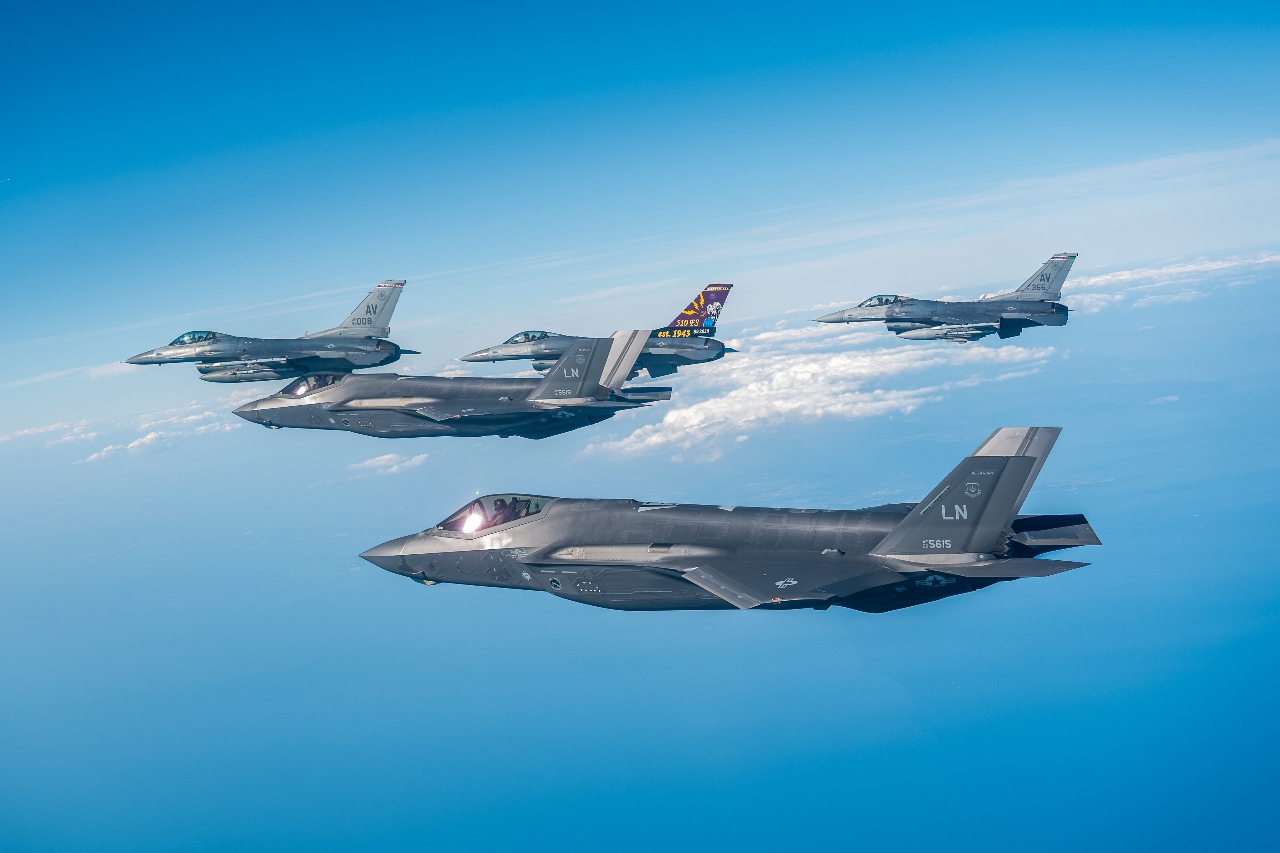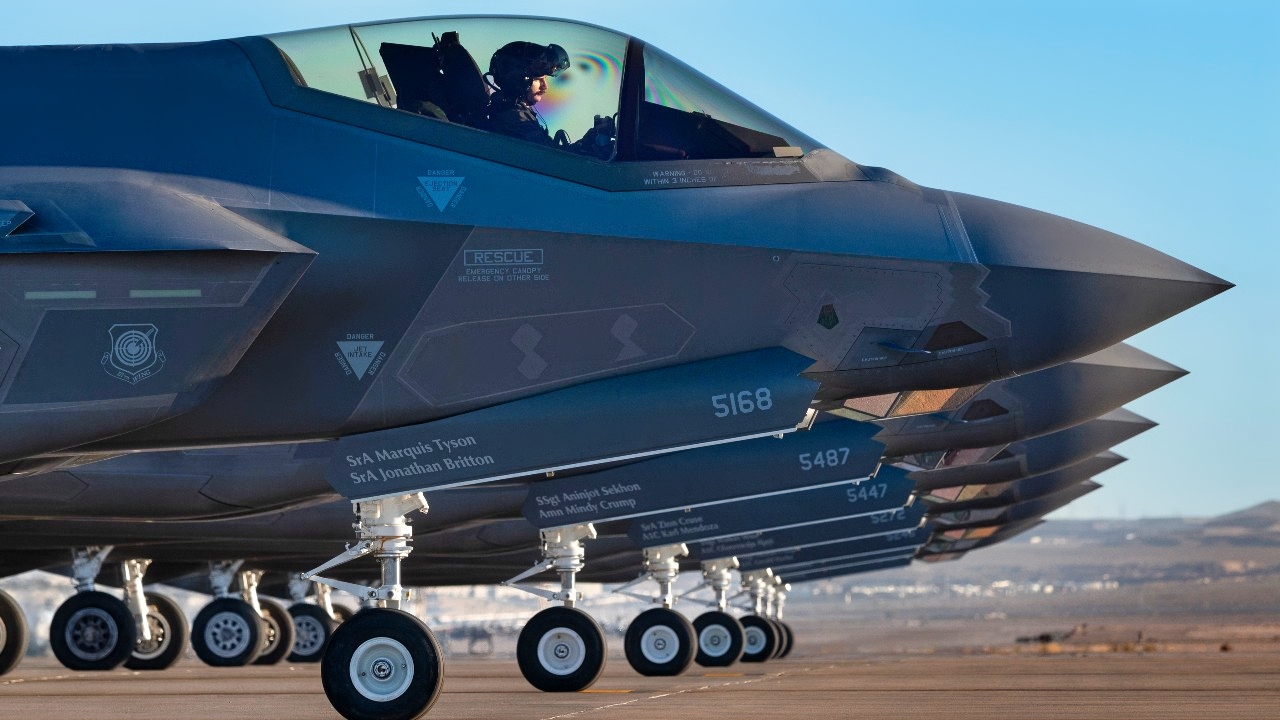Key Points and Summary – The Air Force will pare back F-35 purchases through 2028, citing Block 4 upgrade and TR-3 computing delays, and will re-accelerate once “most relevant” jets are available.
-GAO now pegs full Block 4 to 2031. The service still targets 1,763 F-35As but is prioritizing sixth-gen F-47 NGAD development and Collaborative Combat Aircraft, while upgrading legacy fleets.

A formation of U.S. Air Force F-35 Lighting IIs and F-16 Fighting Falcons assigned to the 48th and 31st Fighter Wings respectively fly in formation as a part of Exercise Combined Strike along the coast of Italy, August 18, 2025. Exercises like Combined Strike ensure USAFE remains ready and postured to rely on one another to defend the area of responsibility. (U.S. Air Force photo by Senior Airman Zachary Jakel)
-Recent buys: 51 (2024), 44 (2025), 24 (2026), then 39 (2027), 18 (2028), 32 (2029), 29 (2030).
-Despite the USAF pause, foreign demand is surging, with deliveries projected to reach ~200 in 2025. Net: budget shifts fund NGAD/CCA now; mature Block 4 F-35s later.
Air Force Cutting Back On F-35 Purchases Until Upgrades Ironed Out
The United States Air Force is currently planning to reduce the number of F-35s it plans to acquire through 2028. Meanwhile, the first sixth-generation F-47 stealth fighter is expected to fly in 2028.
Defense One reported that the Air Force plans to cut the number of F-35 purchases in half by 2026 and won’t resume complete F-35 orders until Lockheed Martin resolves its upgrade issues. Gen. Davil Allvin told Defense One at the Royal International Air Tattoo that the service will increase procurement again when it can buy “F-35s that are most relevant for the fight.”
“In the end, because we have limited financial resources, we need to make sure that the F-35s we buy have the capability to meet the pacing threat. So, some of the delays with respect to Block 4 and TR-3 weighed into decisions by the department,” Allvin added.
Block 4 Upgrades For the F-35
The F-35 Block 4 upgrade is a significant modernization effort aimed at enhancing the jet’s weapons, sensors, and electronic warfare capabilities, although it has been delayed and has gone over budget.
Key improvements include increased missile capacity, enhanced sensors and target recognition capabilities, advanced electronic warfare systems, and improved interoperability. These upgrades rely on the integration of the new Technology Refresh 3 (TR-3) computing infrastructure, which is a prerequisite for Block 4.

Seven F-35 Lightning II aircraft wait to take off for a U.S. Air Force Weapons School training mission at Nellis Air Force Base, Nevada, Jan. 31, 2024. The U.S. Air Force Weapons School teaches graduate-level instructor courses that provide advanced training in weapons and tactics employment to officers and enlisted specialists of the combat and mobility air forces. (U.S. Air Force photo by William R. Lewis)
“Block 4 upgrades add new and enhanced capabilities to ensure our platform remains relevant against rapidly evolving threats,” said Lt. Gen. Michael Schmidt, F-35 Program Executive Officer.
“Much like a new mobile cell phone or personal computer, TR-3 will host new Block 4 capabilities and applications with significantly more computing power and memory than the legacy infrastructure.”
However, the Block 4 upgrades are delayed an additional two years from the projected 2029 timeframe until 2031, according to the Government Accounting Office (GAO).
Air Force Still Wants The Same Number Of F-35s
The USAF’s program of record remains purchasing 1,763 F-35As.
However, Air Force officials have made it clear that they want a fully capable Block 4 F-35 fighter from the start, rather than receive jets that will need to be retrofitted with the full suite of upgrades, which includes new software, weapons, sensors, and a new processor, that they claim will be needed in a shooting war with China.
The Air Force is also looking to allocate more of its budget to upgrading its existing fleets of fighter jets. It has to balance new procurements with maintaining and upgrading current jets, as well as the costs of developing new systems.
According to a new report submitted to Congress, the Air Force budget documents indicate that it purchased 44 in 2025 and has received funds to buy 24 more in 2026. In 2024, the Air Force purchased 51 of the aircraft. The Air Force plans to purchase 39 F-35s in 2027, 18 in 2028, 32 in 2029, and 29 in 2030.
Lockheed Martin F-35 Production Isn’t Slowing Down
Despite the Air Force’s purchase delay, the production of the F-35 is reaching new heights due to foreign sales.
Although Spain and Portugal have chosen to look elsewhere (for now) for their fighter aircraft, and Canada continues to drag its feet on the F-35, business is booming.
Germany and Morocco are moving forward with purchases, and Saudi Arabia plans to purchase 48 F-35As in the near future. Following a visit to Washington, D.C., it appears that the Pentagon will clear the Saudis to become the next country to field the F-35 in a contract worth billions.
Defence Industry Europe is reporting Lockheed Martin is planning to deliver up to 200 F-35s in 2025. This will be record-breaking and likely exceed all other Western and even Russian fighter jet deliveries for 2025 combined. It represents a significant increase from the 110 F-35s delivered in 2024.

A U.S. Air Force F-35 Lightning II from the 48th Fighter Wing approaches a KC-135 Stratotanker from the 100th Air Refueling Wing during an aerial refueling mission as part of combat readiness inspection Skyway Chariot over the North Sea, May 8, 2025. Skyway Chariot was designed to assess how effectively the 100th ARW could operate under constrained conditions in the face of a potential threat. (U.S. Air Force photo by Airman 1st Class Aidan Martínez)
Priorities Shifting to the NGAD F-47
Secretary of War Pete Hegseth announced an eight percent shift of DOD funds to pay for new priorities from the Trump administration, and the Air Force needed money to move ahead with a sixth-generation stealth fighter aircraft, the F-47.
The F-47 program is receiving increased development funding in the fiscal year (FY) 2026 budget to accelerate its readiness, while actual purchases of other fighter jets, including the F-35, are being reduced.
The Air Force plans to purchase at least 185 F-47s, which would replace the F-22s currently in its inventory.
Also included in Secretary Hegseth’s funding shift is the Air Force’s Collaborative Combat Aircraft (CCA) program.
The Collaborative Combat Aircraft program is a U.S. Air Force initiative to develop autonomous, uncrewed aircraft that will operate alongside and be controlled by manned fighters.
These aircraft are designed to increase fighter capacity, enhance capabilities, and reduce risk to pilots in combat. The program employs a competitive, multi-vendor approach with open-system architectures, enabling rapid development, iterative upgrades, and cost-effectiveness.
Both the F-35, the F-47, and the F-22 Raptor will incorporate the use of multiple CCA aircraft, the “loyal wingman” that will increase US combat airpower across the board.
About the Author: Steve Balestrieri
Steve Balestrieri is a National Security Columnist. He served as a US Army Special Forces NCO and Warrant Officer. In addition to writing on defense, he covers the NFL for PatsFans.com and is a member of the Pro Football Writers of America (PFWA). His work was regularly featured in many military publications.
More Military
Russia’s Mach 2 Su-30SM Fighter Has A Message for Any Air Force on Earth
The Mach 2.2 B-1A Bomber Has A Message for the U.S. Air Force
The Mach 2.35 ‘Super’ Eurofighter Typhoon Fighter Has a Message for Any Air Force On Earth
Canada’s CF-18 Hornet Fighter Crisis
Forget NGAD or the J-20: A 7th Generation Fighter Could Hit Mach 5










